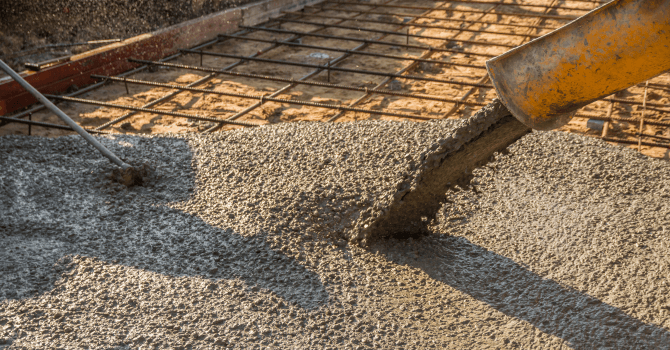Patio Pavers: How to Choose the Right Ones
By Editorial Team
Updated on May 30, 2025

Building a patio is a great way to elevate your outdoor space, designing the ideal area to lounge, entertain guests, or simply enjoy the outdoors. Choosing your patio pavers isn’t just a stepping stone, but the initial step, impacting not only your patio’s aesthetics, but also its long-term durability and maintenance. Whether you’re looking for something natural, modern, or unique, this article will guide you through the essential criteria to consider when selecting the perfect pavers for your patio space.
The Different Types of Patio Pavers

Source: Canva
Concrete Patio Stones
This is the most common type of patio stone. A 12-inch by 12-inch white concrete square that perfectly mimics stone, to the point of closely resembling a slab. Concrete is extremely versatile, making it entirely feasible to design a circle-like pattern.
Patio Pavers
Whether made of stone or concrete, patio pavers can be:
Square
Rectangular
Brick-like
Pigmented (grey, ochre, beige, brick)
Just like all pavers, they can be used to design stunning geometric patterns when laid by landscaping experts. For example, they can be used to create a 9-foot, 5-inch circle or a two-circle configuration measuring 6 feet and 5 inches.
Round Pavers for a One-of-a-Kind Design
Round pavers are perfect for designing a standard, paver-made circle centrepiece, but with a rounded edge; they make for perfect circular shapes.
Another way to use round pavers is to purchase several pavers with differing diameters, installing them one against the other, the smallest to the largest. Using this design method, you can add a bit of a vertical-like feature to your patio’s surface, adding the statue or flower pot to this design set-up.
Natural Stone Pavers or Outdoor Tiles
Natural stone pavers are typically composed of one of the following three materials:
Granite
Slate
Lava stone
Since the above-listed stones are natural, stone patio pavers have different colours, perfectly mirroring the landscapes from which they originate. They also don’t require much maintenance or upkeep (a bit of warm water and soap) and are very hard-wearing.
Outdoor tiles are composite patio pavers (wood and recycled plastic), with a wood-like appearance. They’re manufactured in such a way that even their texture mimics the characteristics of wood.
Here are the primary advantages of such outdoor tiling:
Weatherproof
UV-resistant (non-fading colour)
Harder-wearing than wood
Using recycled plastic makes outdoor tiling an eco-friendly adjacent material.
In retail stores, they’re marketed as deck or balcony tiles.
Stones vs. Pavers
The reality is that to cover an outdoor space, the choice is entirely yours. In fact, the primary difference between stones and pavers is material thickness. In other words, pavers are thicker and are recommended for high foot traffic or vehicular areas. On the other hand, stones aren’t made to withstand regular dead loads, let alone one that’s distributed across four tires.
Choosing Stones Based on Patio Size

Source: Canva
12x12 Stones: Ideal for Smaller Areas
As we previously mentioned, this is the standard size of commonly used concrete patio stones. They’re perfect if your patio surface area is on the smaller side.
16x16 Stones: A Versatile Choice
16-in by 16-in stones are an interesting compromise between small and large-sized patio spaces. Such patio stones allow one to limit the number of tiles used and, therefore overall costs too.
These are just as aesthetically pleasing as 12-inch by 12-inch stones, yet all things considered, they’re a much more cost-effective choice.
24x30 Stones: For Large Patios
These big paver stones can only be laid for the makings of a large-sized patio space, unless you’re willing to set aside the idea of having an aesthetically pleasing shape. When used to cover large spaces, it definitely gives the patio a visually appealing look, appearing bigger than it actually is, with a charming look that can’t be achieved using smaller tile formats.
How to Install and Cut Patio Stones: Guidelines

Source: Canva
10 Patio Stone Installation Steps
Step 1: Inspect the ground
The soil type on which you’ll lay your stones or pavers will directly affect the type of foundation you’ll need to have. In Quebec, most properties are built on clay soils. Follow along our detailed guidelines to learn which foundation is best suited for your project.
Step 2: Outline the surface
With the help of stakes and a mason line, outline the area you’ll dig out to make your foundation.
Step 3: Excavate foundation
In areas where clay soils are found, the ideal foundation size for patio stones is at least 12 inches. Digging that deep will allow you to add must-have elements to ensure your stones or pavers hold up over time.
Step 4: Compact the soil
Once you’ve dug out the foundation, you can compact the soil using just about any compacting tool at your disposition:
Manual compactor
Drum roller
Plate compactor
Among others
To ensure your foundation is as strong as can be, remove any rocks, roots, or other obstacles found in the dugout.
Step 5: Drainage
Drainage might be the most important step to ensure your patio pavers or stones stand the test of time. To do so, your stones or pavers must be laid along a 2-5% slope.
At the same time, at the bottom of your dugout, add a geotextile or landscape fabric to protect your stones or pavers from rising water during heavy rainfalls.
Step 6: Add crushed stones
Over a roughly 4-inch thick surface area, add layers of 0/3/4 crushed stone, compacting the material between each new layer.
Step 7: Sand bed
Whether it be sand or stone dust, add a layer of granular material. Once this step is completed, check the surface to ensure it still has a 2-5% slope.
Step 8: Avoid treading on the surface
If you walk on the surface just made before laying the patio stones, you risk disrupting the sand bed, resulting in granular shifts. Then, when it comes time to lay the stones, the surface will have been pushed in, which will negatively affect your patio stones over time.
Step 9: Follow the installation design plan
This is where a DIY patio stone installation will differ from one done by a professional. If you’re not looking to create a specific geometric pattern, laying the stones will be a relatively easy feat.
However, if you want to create shapes to add an aesthetic appeal to your patio, not only will you have to follow along a meticulously designed plan, but you’ll also most likely need to hire a professional at some point.
Step 10: Fill in the joints
Last, but not least, fill in the gaps between every stone with polymeric sand. To ensure everything stays in place from that point on, run a vibrating plate over your patio stones. Doing so will allow you to spot any gaps that further need to be filled with polymeric sand.
Compact the surface once again, then allow your new patio surface to set over a 24-hour period.
How to Cut Patio Stones
We already delved into great detail about the different patio stone sizes. To create the most stunning outdoor surface area, the best way to do so is by alternating patio stone sizes. However, we’re not talking about a random design here.
You’ll need to pick a pattern, create a precise stone layout plan, then lay them accordingly, without deviating from your original plan. Once you’re nearing the edges of the surface, cut your stones accordingly.
The cut can be made with a:
Wet-saw
Standard saw
It the event of performing a dry-cut, you can use an angle grinder. Here’s its main advantages:
You probably already own one
Discs are easy to install
But also has a couple of downsides:
Dusty
Limited material thickness depending on the angle grinder
Wet cutting can be done with a much bigger grinder. It allows for the following:
Carry out large-scale projects
Efficiently cut numerous patio stones
Has a fixed cutting guide
The process isn’t as dusty (water-cooled)
Suits 15-inch (400 mm) diameter grinding discs
However, wet cutting also has a couple of drawbacks:
Heavy tool
Not as easily portable
Maintenance: How to Clean Patio Stones

Source: Canva
Water and a heavy-duty deck brush are your best bets. Forget about a pressure washer, it’s likely to create micro-fissures in your patio stones.
To prevent time-consuming and arduous cleanings, check your surroundings after every meal to ensure there aren’t any spilled foods or oil stains on the surface. If so, grab a paper towel or dry rag and clean the surface.
If you aren’t sure which products to use, note that dishwashing soap should get the job done. Otherwise, refer to the manufacturer’s maintenance instructions to select a product that was specifically designed for your stones or pavers.
Paving the Way to a Dream Patio: Picking Out the Best Stones
Choosing the best pavers or stones for your patio is a critical step that combines aesthetics, functionality, and durability. There are different factors to consider before making your final decision, such as:
Material
Colour
Texture
Weatherproof and hard-wearing
Opt for pavers or stones that blend with your home’s architectural style, while also meeting your use-related needs, ensuring your outdoor space isn't only elevating the look of your property, but also serving as a lounge and entertainment-prone area for years to come.
Looking for something else?
Related articles
The latest industry news, interviews, technologies, and resources.

Cynthia Pigeon
•07 Nov 2023
Whether for interior or exterior work, knowing how to pour a concrete slab is vital for anyone wanting to carry out major home renovations. This process can be a bit tricky, especially since you have to follow certain steps to a T, otherwise, the slab could crack prematurely.

Cynthia Pigeon
•02 Aug 2024
When you start building or renovating your house, you’re faced with many choices, especially in terms of land location, the type of house you want (or have), the types of materials to be used, etc. Regarding the latter, it's imperative to select quality masonry materials to have a solid foundation, which will withstand heavy loads and the test of time. That said, are you looking to make an informed decision about which products to use? This article will allow you to get an overview of the types, brands, and prices of commonly used masonry materials.

Editorial Team
•07 Nov 2023
We can’t deny that painting usually turns out to be a time-consuming activity. Most homeowners love the idea of a fresh coat of paint, but the process of getting there can be tricky. This labour-intensive job needs attention to detail and perseverance, especially if you’re dealing with the age-old debate of how many coats of paint are necessary.

Cynthia Pigeon
•31 Mar 2025
Knowing when and how to remove snow from your roof can be tricky, as several factors influence snow accumulation and weight. An excessive load can put your home's structure at risk, but clearing snow too early or too often can also cause unnecessary damage.

Léa Plourde-Archer
•24 Jul 2025
Everyone sets up their bedroom according to their own preferences. Some people want to adapt it to their own tastes, by putting a lot of effort into the room's decor, whereas others opt for a minimalist layout. The main goal of a bedroom is to provide a place for rest and privacy.